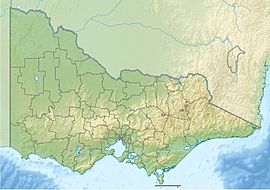Deep Lead Nature Conservation Reserve facts for kids
Quick facts for kids Deep Lead Nature Conservation ReserveVictoria |
|
|---|---|
|
IUCN Category Ia (Strict Nature Reserve)
|
|
| Nearest town or city | Stawell. |
| Established | August 1982 |
| Area | 1,120 hectares (2,800 acres) |
| Managing authorities | Parks Victoria |
| Website | Deep Lead Nature Conservation Reserve |
| Footnotes | IUCN |
| See also | Protected areas of Victoria |
The Deep Lead Nature Conservation Reserve is a special protected area in Victoria, Australia. It's located in the western part of the state, just north of the town of Stawell. This area was once famous for gold mining. Today, it's a peaceful home for many different types of Eucalyptus trees. These trees provide a safe habitat for a variety of birds and mammals, including some rare and endangered species. You can also find several types of rare ground orchids growing here.
Contents
A Glimpse into Deep Lead's Past
Traditional Owners and Early History
The Djab wurrung and Jardwadjali people are the traditional owners of the Deep Lead area. They have lived on this land for thousands of years. The area became a gold-mining site after the Australasian Mining Company found gold in 1867. They discovered what was called the "Australasian Lead" – a deep underground gold deposit.
The Mining Accident of 1882
Gold mining was a dangerous job. The first mine shaft at Deep Lead had to be closed after about ten years because it kept flooding with water. In 1878, a second shaft was dug nearby. It went down about 80 meters (260 feet) deep.
On December 12, 1882, something terrible happened. Workers accidentally broke into the old, flooded mine workings. Water quickly began to fill the new shaft. Despite the desperate efforts of the workers trying to pump out the water, only five of the 27 miners managed to escape. Most of the mining equipment has been removed from the site today. However, you can still see the dip in the ground where the flooded shaft was. A special stone monument and trees mark the spot of this sad event.
Protecting Nature at Deep Lead
How the Reserve Was Created
The Deep Lead Nature Conservation Reserve was first set up in 1982. At that time, about 1,120 hectares (2,768 acres) of land were put aside for protection. Later, in 2002, another 750.6 hectares (1,855 acres) were added. This made the reserve even larger, helping to protect more of its unique environment.
Exploring the Reserve
The reserve has many tracks that you can explore. However, there are no camping facilities available. To protect the natural environment, searching for gold or other minerals (called prospecting or fossicking) is not allowed.
Plants and Animals of Deep Lead
Amazing Plant Life
The Deep Lead Reserve is home to about 350 different kinds of native plants. The most common trees are various types of eucalyptus, also known as gum trees. These include:
- Red ironbark (Eucalyptus tricarpa)
- Yellow gum (Eucalyptus leucoxylon)
- Yellow box (Eucalyptus melliodora)
- Long-leaf box (Eucalyptus goniocalyx)
- Red stringybark (Eucalyptus obliqua)
- River red gum (Eucalyptus camaldulensis)
- Grey box (Eucalyptus microcarpa)
Below the tall gum trees, you'll often see wattles, especially the golden wattle (Acacia pycnantha). This plant is famous for its bright yellow flowers. Sometimes, rare ground orchids can also be spotted.
Wonderful Wildlife
Many different birds and mammals live in the Deep Lead Reserve. It's a great place for wildlife spotting! You might even see some endangered species here. The endangered swift parrot (Lathamus discolor) sometimes visits the reserve. Another rare animal is the endangered squirrel glider (Petaurus norfolcensis). These small, furry creatures are nocturnal, meaning they are active at night, so they are rarely seen during the day.
What "IUCN Category IA" Means
As of 2016, the Deep Lead Nature Conservation Reserve is classified as an IUCN Category IA protected area. This is a very strict category of protection. It means the area is mainly set aside for scientific research or environmental monitoring. Human visits are usually limited to make sure the natural environment is disturbed as little as possible. It shows how important this reserve is for protecting nature.


